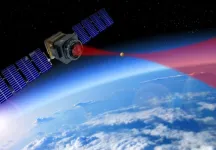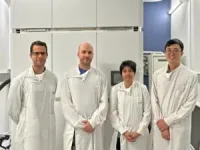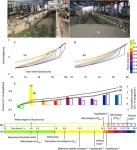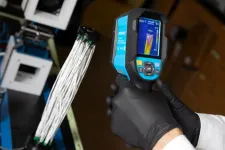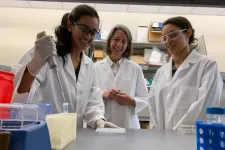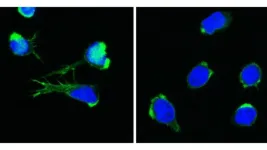(Press-News.org) A UK-wide consortium is developing technologies to use nanoparticles as state-of-the-art sensors on small, shoebox-sized satellites known as CubeSats.
The Universities of Warwick, Swansea and Strathclyde have been awarded £250k to further research into nanoparticles and quantum physics in the application of space technology.
Recent advances in the field of levitated optomechanics (the motion of tiny particles held and measured in free space by laser light), have shown that nanoparticles can exhibit behaviours that are governed by the laws of quantum mechanics (a fundamental theory which describes how atoms and subatomic particles interact).
This has led to nanoparticles, which are a thousand times larger than an atom and a thousand times smaller than a single grain of sand, being investigated as new sensors in laboratory conditions. But scientists are yet to apply this to the real world – and beyond.
Now, in an Enabling Technologies Programme funded by the UK Space Agency (UKSA), researchers are pushing the limits of quantum technology so that nanoparticles can be used as sensors in space. ‘Levitated Optomechanical Technologies In Space’ (LOTIS) is an 18-month project to develop technologies to enable future space-borne devices using nanoparticles.
LOTIS will develop devices which are small, lightweight, and, rather than car-sized satellites, can fit on more compact nanosatellites the size of a shoebox, known as CubeSats. This approach dramatically lowers development and launch costs.
There are many applications for nanoparticles as sensors. Little is known of the density of the thermosphere – a layer of the Earth’s atmosphere which begins around 80km above sea level, and this technology could shed detailed light on this. Determining the density of the region has spaceflight applications; understanding the drag experienced by satellites in orbit, helping to map their trajectories.
The project also aims to develop gravimeters (devices for measuring gravitational fields), which is especially useful back on Earth as a tool in geophysics and Earth observation. As gravity permeates through opaque objects, gravimeters can help map what is underneath the ground – particularly useful for civil engineering or monitoring aquifers.
LOTIS will also underpin technologies for the proposed macroscopic quantum resonators (MAQRO) mission which seeks to test the predictions of quantum mechanics of increasingly larger objects, with greater masses. This is vital for understanding the validity of quantum mechanics – which typically describes the behaviour of small objects, atoms and subatomic particles, but not objects larger than this.
Dr James Bateman, Physics, University of Swansea, said: “I am thrilled to lead this UKSA project, which will create the necessary technologies to establish a functioning sensing platform for both space and terrestrial applications. Our team is comprised of experts in nanosatellites, quantum sensing, and experimental optomechanics, and this project will help to make levitated optomechanical sensors a reality.”
Professor Animesh Datta, expert of Theoretical Physics at the University of Warwick, said: “LOTIS is a concrete step towards the realisation of a new generation of experiments that will help shed light on the interface of quantum mechanics and gravity. I look forward to contributing to its success.”
Quantum theorist Dr Daniel Oi, Physics, University of Strathclyde, added: “We are developing highly sensitive sensors for satellites which are greatly reduced in size and able to perform measurements of the space environment. This is part of a wider, international quantum technology programme which will extend its applications from Earth and space bound applications.”
Further details can be found here: https://levitation.wales
END
Space tech to shrink as the limits of quantum physics are tested on Earth and beyond
Scientists are to build technologies to use and study nanoparticles in space – pushing the limits of quantum technologies
2023-06-22
ELSE PRESS RELEASES FROM THIS DATE:
Adrian Krainer named 2023 recipient of IADR Honorary Membership
2023-06-22
Alexandria, VA, USA – The International Association for Dental Research (IADR) has announced Adrian Krainer as the 2023 recipient of IADR’s Honorary Membership. Krainer, from Cold Spring Harbor Laboratory, New York, USA, was recognized during the Opening Ceremonies of the 101st General Session of the IADR, which was held in conjunction with the 9th Meeting of the Latin American Region and the 12th World Congress on Preventive Dentistry, that took place on June 21, 2023, in Bogotá, ...
New research shows vegetation accelerates coastal dune erosion during extreme events
2023-06-21
INTRODUCTION
Coastal sand dunes provide the first line of defense from storms for some of the most economically valuable and ecologically important landscapes in the world (1–3). A current and broadly accepted paradigm is that vegetation reduces the erosion of these dunes during wave attack (4–7). The existing body of dune research shows that a greater size (8), density (9–11), and diversity (12) of plants are associated with less erosion, although these studies have been limited ...
Inside-out heating and ambient wind could make direct air capture cheaper and more efficient
2023-06-21
What started as a simple errand to deposit a check at a bank drive-through became the kind of “aha” moment found mostly in books and movies.
Georgia Tech researchers had been working on an idea to simplify traditional direct air capture (DAC) systems. Their approach used ambient wind flow to draw air across a new kind of coated carbon fiber to grab CO2. That would eliminate the loud fans used in many systems. And the carbon fiber strands could be quickly heated to release the captured carbon dioxide with ...
A clean energy transition is possible for China’s manufacturing industry
2023-06-21
The industrial sector – made up of businesses that support processing raw materials for manufacturing and consumer goods – is a major contributor to greenhouse gas emissions and one that has proven difficult to decarbonize. In China, much of the industrial sector is organized into ‘parks’ that have been zoned as areas for concentrated industrial activities. China has more than 2,500 industrial parks that are currently largely powered by coal. A recent study led by researchers at Princeton University finds that this clustering of industry provides unique and overlooked opportunities for targeted energy supply emissions reduction ...
Antarctic ice shelves experienced only minor changes in surface melt since 1980
2023-06-21
Antarctic ice shelves have experienced only minor changes in surface melt rates over the past four decades, unlike the rapid increase in surface melt experienced by Greenland’s glaciers during the same time period, according to new research. The news is not cause for celebration just yet, though—the researchers expect Antarctic ice shelf surface melt rates to increase substantially in the coming decades due to rising global air temperatures.
Ice shelves are the parts of glaciers that extend into the ocean and float on top of seawater. In a new study published today in Geophysical Research Letters, glaciologists ...
Hastings Center partners on AI project led by national academies
2023-06-21
The National Academy of Medicine (NAM) is partnering with a group of leading health, bioethics, equity, tech, patient advocacy, and research organizations, including The Hastings Center, to develop an Artificial Intelligence Code of Conduct (AICC).
Dr. Vardit Ravitsky, incoming president of The Hastings Center, who will serve on the steering committee, said, “we must urgently develop guidance for the ethical use of AI – perhaps the most transformative technology of our generation.” ...
CSU biologists document genome-level climate adaptation in endangered bird species
2023-06-21
As the climate changes, living things must adapt to new environmental conditions in one of two ways – either geographically or genetically. While it’s relatively simple for scientists to track and record a species’ geographic movements, proving their genetic adaptation over time can be much more difficult.
A new study led by Colorado State University researchers in Nature Climate Change is one of the first to document climate adaptation at the genomic level in a wild population. Specifically, the Southwestern Willow Flycatcher – an endangered migratory bird – has shown an increase in genetic variation ...
DNA test could broaden access to cervical cancer screening
2023-06-21
HOUSTON – (June 21, 2023) – Rice University bioengineers have demonstrated a low-cost, point-of-care DNA test for HPV infections that could make cervical cancer screening more accessible in low- and middle-income countries where the disease kills more than 300,000 women each year.
HPV, a family of viruses, infects nearly everyone at some point in their lives, often without symptoms. But more than a dozen types of HPV can cause persistent infections that result in cervical cancer, which is preventable and curable ...
Cancer drugs show potential in fight against malaria
2023-06-21
With malaria becoming increasingly drug-resistant, a team of UCF researchers is looking to use cancer drugs to accelerate the discovery of new life-saving therapies for the disease.
In a study funded by a 5-year $3.8 million grant from the National Institutes of Health, UCF molecular parasitologist Debopam Chakrabarti and cancer molecular biologist Ratna Chakrabarti are partnering with Nathanael Gray, co-leader of the cancer therapeutics research program at Stanford University and Elizabeth Winzeler, a malaria drug development expert from the University of California San Diego, to test cancer drugs for malaria-fighting ...
Newly discovered genetic defect disrupts blood formation and immune system
2023-06-21
(Vienna, 21.06.2023) In the quest to find the origin of the puzzling symptoms in four children, researchers from St. Anna Children's Cancer Research Institute, the CeMM Research Center for Molecular Medicine of the Austrian Academy of Sciences (ÖAW), and the Medical University of Vienna have discovered a completely new disease, linking disruptions of blood formation, the immune system, and inflammation. This groundbreaking discovery provides the basis for a better understanding of similar diseases. It is a milestone that the researchers have now published ...
LAST 30 PRESS RELEASES:
Electrodes created using light
Second-hand gift-giving is a well-deliberated decision
How human interaction drove evolution to make bears less aggressive
National Poll: Few parents offer teens guidance on healthy eating during holiday season
Cannabis derivatives could provide new ovarian cancer treatments
Raising strong yeast as a petroleum substitute
Clues to the origin of hot Jupiters hidden in their orbits
Canada’s reduced pledge to Global Fund will impact domestic health
1 in 4 children with major traumatic injuries not cared for in pediatric trauma centres
Duke and Duke-NUS’ joint cross-population research to uncover "East-West" differences in disease and care
Scientists to ‘spy’ on cancer- immune cell interactions using quantum technology breakthrough
Tech savvy users have most digital concerns
Making lighter work of calculating fluid and heat flow
Normalizing blood sugar can halve heart attack risk
Lowering blood sugar cuts heart attack risk in people with prediabetes
Study links genetic variants to risk of blinding eye disease in premature infants
Non-opioid ‘pain sponge’ therapy halts cartilage degeneration and relieves chronic pain
AI can pick up cultural values by mimicking how kids learn
China’s ecological redlines offer fast track to 30 x 30 global conservation goal
Invisible indoor threats: emerging household contaminants and their growing risks to human health
Adding antibody treatment to chemo boosts outcomes for children with rare cancer
Germline pathogenic variants among women without a history of breast cancer
Tanning beds triple melanoma risk, potentially causing broad DNA damage
Unique bond identified as key to viral infection speed
Indoor tanning makes youthful skin much older on a genetic level
Mouse model sheds new light on the causes and potential solutions to human GI problems linked to muscular dystrophy
The Journal of Nuclear Medicine ahead-of-print tip sheet: December 12, 2025
Smarter tools for peering into the microscopic world
Applications open for funding to conduct research in the Kinsey Institute archives
Global measure underestimates the severity of food insecurity
[Press-News.org] Space tech to shrink as the limits of quantum physics are tested on Earth and beyondScientists are to build technologies to use and study nanoparticles in space – pushing the limits of quantum technologies
